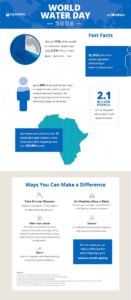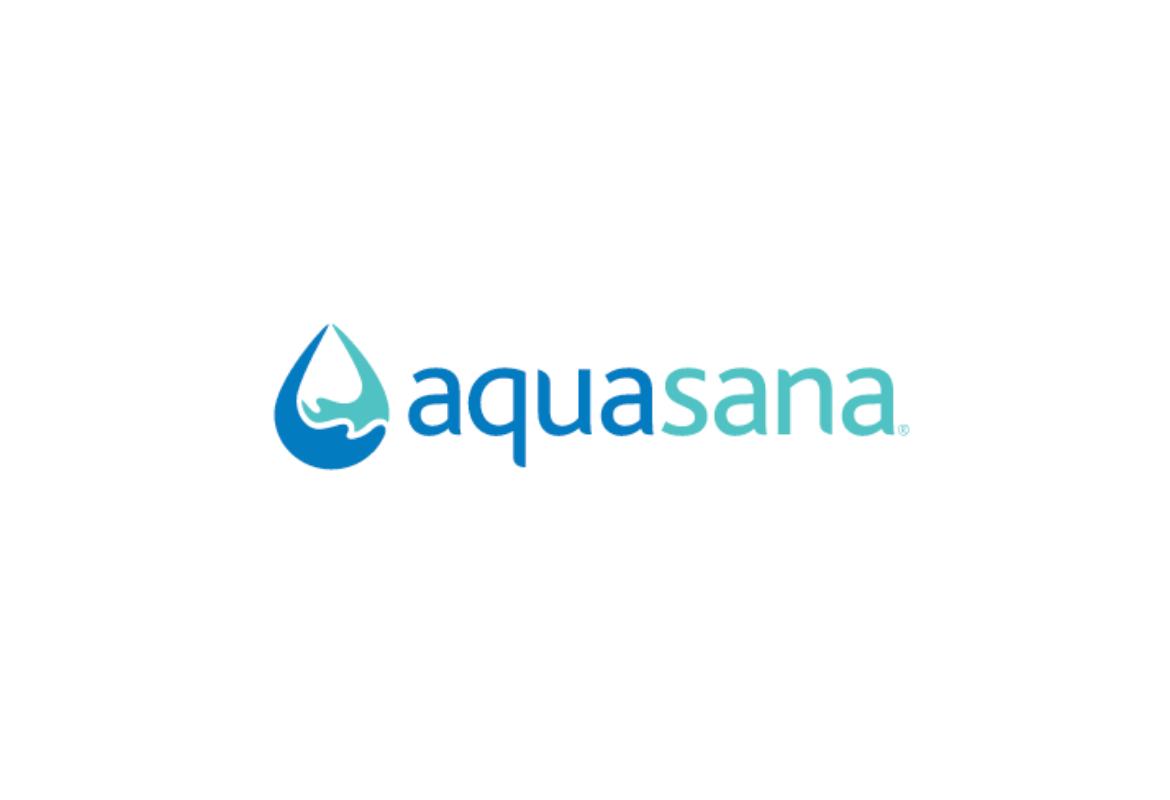March 10, 2020
Guest Post: 10 Ways You Can Make a Difference for World Water Day
What is World Water Day?
World Water Day was first proposed in 1992 at the United Nations Conference for Environment and Development in Rio de Janeiro. Although the idea for the observance day was brought up in 1992, it didn’t go into effect until the following year. Thus, the first World Water Day was March 22nd, 1993.
What is the goal of World Water Day?
World Water Day supports the UN’s Sustainable Development Goal 6: water and sanitation for all with a target completion date of 2030. In fact, this goal is of such importance that the UN has also declared 2018-2028 Water Action Decade to prioritize the ongoing issue. Specifically, World Water Day asks people to spread awareness about the ongoing water crisis worldwide and take action in their community.
What is the 2020 theme for World Water Day?
Each year, a theme is chosen for World Water Day. In 2019, the theme was “Leaving no one behind” to emphasize that we as a society cannot leave anyone behind as sustainable development progresses. The 2020 theme for World Water Day is “nature and climate change”, which focuses on the link between water and climate.
In the 2020 campaign, the UN discusses the rising demand for water coinciding with global population growth. The campaign notes that water is our most valuable resource, and we cannot afford to wait—policymakers must take action now before it’s too late. The campaign also discusses how water can help fight climate change through scalable water solutions that are sustainable and affordable.

10 Things You Can Do to Make a Difference on World Water Day
According to the World Health Organization, half of the world’s population will be living in water-stressed areas by 2025 if we don’t take action now. This World Water Day, do your part to help resolve the water crisis by doing any or all of these actions:
1. Take shorter showers
How long do you spend showering? Home Water Works found the average American showers about 6 times a week for an average time of 8.2 minutes, using 17.2 gallons of water. Over the span of a year, this means a person is likely to spend about 43 hours showering which uses 5,336 gallons of water. Scale this number to account for the other 325.7 million Americans and you’ll find the nation uses about 1.7 trillion gallons of water a year showering — which is enough to fill 2.6 million Olympic swimming pools.
Do your part by cutting your shower time to five minutes in order to conserve water and reduce CO2 emissions. Or, go even further by participating in Well Aware’s Shower Strike and skip showering all together! This nationally-recognized fundraiser unites people across the globe who vow not to shower until they reach their fundraising goal to help build life-changing clean water systems in East Africa. Over the past 11 years, Shower Strikers have raised more than $1.5 million to help provide clean water for over 100,000 people. Learn more about how you can get involved and make a big difference in a short time.
2. Meat-free Mondays
National Geographic found the average hamburger takes about 630 gallons of water to produce. Both animals and their feed require water, which means meat has an especially large water consumption footprint, with beef being the highest. By comparison, plants use far less water which is why many environmentalists encourage people to go meatless at least once a week. In fact, Meat-Free Mondays have even become a popular trend among celebrities, chefs, and health advocates as well.
Each meatless meal saves nearly 133 gallons of water, so do your part by going meatless at least once a week.
3. Filter your water
The World Water Day 2020 campaign explains that “Everyone has a role to play. Households must be more water-efficient.” Filtering water in your home is one of the best things you can do to help address the water crisis. Not only do you get to enjoy clean, healthy water—but filtering your water at home prevents the need for practices such as “flushing”—in which people run cold tap water for several minutes before drinking it. This process has not only been found to be ineffective, it also wastes a significant amount of water. Instead, reduce contaminants using a dedicated water filter.
Many people substitute the water they can drink out of their taps with bottled water or water delivery services because they do not trust their water or like the taste or smell. A filter provides a great way to tackle those issues at home without the need to buy bottled water. You can eliminate bottled and love your water at home with the right filtration system.
Furthermore, you also prevent further contamination from overworked water treatment facilities that cannot handle the influx of contaminated water. By filtering water at home, less contaminants go back into the public water supply.
To remove contaminants from the water in your home and help the environment, consider installing a whole house water filter such as any of the options available from Aquasana. These systems connect at the main water line to instantly provide filtered water from every tap so you can enjoy healthy, great tasting water from any faucet in your home.
4. Volunteer or donate to philanthropic organizations, such as Well Aware
To support our shared clean water mission, Aquasana has donated to Well Aware the funds to provide 250 people in East Africa clean water for life. Donate what you can to organizations dedicated to providing clean water for all such as Well Aware, or help by volunteering and raising awareness for the cause. Well Aware offers several ways for you to get involved such as volunteering at local events, starting a fundraising campaign, or setting up a Water Walk at your company or school.
5. Spread awareness by sharing on social media
Spread the word about World Water Day by sharing our infographic on social media using #WorldWaterDay this March 22nd. Tell others why water conservation is important, what you’re doing to help, and how they can get involved. Additionally, use social media to raise money by donating your birthday to the clean water cause.
6. Save water through xeriscaping
Xeriscaping comes from the phrase “zero-scaping”, as it refers to an irrigation process that saves you from watering your lawn. This is accomplished through several methods, but primarily consists of choosing plants that can survive in dry regions without access to water. Supporters of xeriscaping believe it can reduce water use by anywhere from 50-75%.
You don’t necessarily have to stick with a cacti filled lawn, as there are several tips that enable you to enjoy a luscious lawn without wasting water. For example, you can avoid watering between 10 a.m. to 6 p.m. to prevent evaporation. You can also design your lawn to group plants with similar light and water requirements together, then put high-water-usage plants near downspouts and drainage areas. For more water-saving lawn tips, check out Aquasana’s guide on xeriscaping.
7. Turn off the tap when brushing your teeth and scrubbing dishes
On average, about two gallons of water flow from a faucet each minute—meaning you can save about three to four gallons of water per day by simply turning off the water while brushing your teeth. Follow suit by turning off the tap while doing other daily tasks such as shaving and scrubbing dishes. These simple adjustments add up in the long run, as you can save thousands of gallons of water each year by simply turning off the tap when you’re not directly using it.
8. Encourage policymakers to support clean water legislation
In order to make significant progress, policymakers must support clean water initiatives through meaningful legislation. To do your part: call your member of Congress and tell them you want them to support legislation that aims to address the water crisis. If you have time to spare, you can also visit their office or write them a letter.
For assistance contacting policymakers, see the government’s help page to find your elected official.
9. Organize a local event
If you have an idea in mind, you can organize your own local event to support World Water Day. Popular events include fun runs, concerts, and tree planting—but don’t be afraid to think outside of the box! If you need inspiration, you can check out Well Aware’s event page to see what they’ve done in the past and what they have planned in the future.
For assistance organizing an event in your community, check out World Water Day’s act page where you can find branded materials and upload your event for others to see.
10. Bring your own bottled water
Did you know that it takes at least twice as much water to produce a plastic water bottle as the amount of water contained in that bottle? Additionally, single-use, plastic water bottles take over 1,000 years to biodegrade and approximately 80% of these water bottles will become litter in the U.S. The manufacture and distribution of single plastic water bottles is also a significant source of carbon emissions.
Rather than relying on single-use plastic bottles which wastes water in production and exacerbates trash issues—stick to a reusable water bottle to do your part and help the planet. Filter your water at home and use your favorite bottle of choice, or use a water bottle with a built-in filter to reduce contaminants on the go.
HELP SOLVE THE WATER CRISIS TODAY
Everyone has a role to play when it comes to water conservation. Do your part by participating in any or all of the water-saving actions noted above. Simple changes can make a significant impact, so do what you can and encourage others to join your cause.
Have additional questions on how you can help? Contact Aquasana or Well Aware to learn more!
